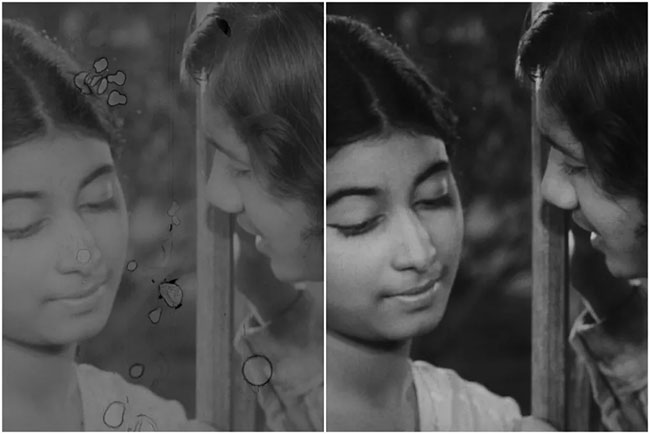Cannes Classics: Inside the challenging restoration of Sri Lankan masterpiece ‘Gehenu Lamai’
May 17, 2025 12:43 pm
As Sumitra Peries’ landmark 1978 debut “Gehenu Lamai” (The Girls) prepares for its restored world premiere at Cannes Classics, India’s Film Heritage Foundation has revealed the extraordinary technical challenges overcome during the film’s painstaking restoration process.
The black and white classic returns to screens 47 years after its original release, following a complex reconstruction effort.
Set in rural Sri Lanka, the film, honored as the Outstanding Film of the Year at the 1978 London Film Festival, follows Kusum, a dutiful girl who falls in love with Nimal, an upper class boy, in whose house she works. Nimal’s mother is outraged when she finds out about the relationship as Kusum belongs to a lower class and sacks her, leading to Kusum breaking off all contact with Nimal. Her happy-go-lucky sister Soma’s dreams of becoming a beauty queen are shattered when she becomes pregnant and has an illegitimate child.
“The restoration was incredibly difficult and we had to work with three different elements of the film to bring ‘Gehenu Lamai’ back to its original glory,” Shivendra Singh Dungarpur, director of Film Heritage Foundation, tells Variety, detailing the intricate process behind the resurrection of this Sri Lankan masterpiece.
Film Heritage Foundation undertook the delicate restoration under the aegis of FISCH (France-India-Sri Lanka Cine Heritage — Saving Film Across Borders), an international collaboration between Film Heritage Foundation, the Embassy of France and the French Institute in India, and the Embassy of France in Sri Lanka and the Maldives.
Dungarpur detailed the technical marvel behind the restoration, revealing the precarious state of the original materials. “The surviving film elements of ‘Gehenu Lamai’ preserved at the National Film Corporation of Sri Lanka – a 35 mm combined dupe negative and two first generation 35 mm release prints, were shipped to L’Immagine Ritrovata in Bologna,” he explains. “The condition of the three elements had deteriorated with tears, broken sprockets, heavy warping, emulsion damage and shrinkage that also impacted the quality of the sound, besides which the combined dupe negative had embedded subtitles. The film had to literally be reconstructed and restored using the best portions from each element.”
Upon detailed inspection at both the Film Heritage Foundation archive and the Bologna laboratory, conservators discovered the varying conditions of the reels ranged from average to critical. Significant time was invested in meticulously repairing physical damages — addressing damaged perforations, mending tears, and replacing aging tape splices — before high-resolution 4K scanning could begin.
The film comparison stage revealed a fascinating discovery: one of the positive prints was a vintage release of the Sri Lankan version containing additional shots not found in other elements, making it an invaluable reference for the restored version. While the dupe negative offered better overall photographic quality, its embedded subtitles presented a unique challenge.
“Ultimately, the dupe negative’s lower photographic contrast allowed for the recovery of greater detail, making it the primary element used for the restoration,” noted the restoration team report. “This necessitated extensive digital restoration work to correct distortions and faithfully recover the image’s original aesthetic.”
Sound restoration proved particularly complex, with the technical team battling issues including clicks, crackles, hiss, physical gaps, and damaged optical sound tracks that rendered portions inaudible. High levels of electrical noise and distortion further compounded these challenges.
“I had seen the condition of the film elements lying at the National Film Corporation and I knew that if we did not take up the restoration soon, there was a chance that we could lose the film forever,” Dungarpur says. It wasn’t until six years later, when a grant from the French Government through FISCH became available, that this vision materialized.
“But despite the challenges, the restoration is beautiful,” adds Dungarpur. “I only wish that Sumitra Peries was there with us to see the film premiere at Cannes.”
With the restoration complete, the film’s premiere at Cannes Classics takes on special significance for its original stars. Wasanthi Chathurani, who was just 16 when cast as Kusum, says: “I am overwhelmed that ‘Gehenu Lamai’ has been restored by Film Heritage Foundation and will be premiered at the Cannes Film Festival, 47 years after it was released. I was just 16 and studying in a convent school when Sumitra Peries selected me for the role of Kusum. Initially, I was very nervous and almost gave up, but she was so patient and she taught me the nuances of acting and how to face the camera. The character of Kusum will stay etched in my mind forever.”
Ajith Jinadasa, who portrayed Nimal, reflects on the film’s lasting impact: “The relationship between Nimal, the character I played, and Kusum, portrayed so beautifully by Wasanthi Chathurani, was innocent, pure, and without conflict from others – yet, it could not survive the rigid social norms of the time. The film left many heartbroken. Even today, 47 years later, fans still ask me, often emotionally, why I abandoned Kusum. Their anger and passion speak volumes about how deeply the story touched people.”
The premiere at Cannes will be attended by the film’s lead stars Chathurani, Jinadasa and Shyama Ananda, alongside a delegation including Dungarpur, Gayathri Mustachi, chair of the Lester James Peries and Sumitra Peries Foundation, and Dammith Fonseka, actor, director, and head of the Gamini Fonseka Foundation.
Jinadasa believes the restoration will allow new audiences to experience a film that “resonates across generations and borders, perhaps because no other love story of that era so truthfully portrayed the silent battles fought within society and within oneself.” He adds, “This film deserves to live on – not just for nostalgia, but for future generations to understand the soul of our storytelling.”
Source: Variety
--Agencies












